Modernity has tremendously changed human lifestyles, and technology has significantly improved most aspects of our lives. Our world has progressed with the use of G.P.S. Smartphones have replaced clocks and watches for many. However, as small devices now carry out many time-checking tasks, older clocks serve ornamental purposes nowadays. There have been many super decorated clocks in the past. Antique clocks were one of the luxuries of the 16th to 18th and artists and artisans around the world were able to put different variants of clock design in our space.
Are you planning to buy a clock that adds visual appeal to your room? Antique clocks are the best choice because human civilization has shifted from producing artistic clocks to more interesting technologies that can better our world.
There are many Antique clocks in the past, but only a little offers you the elegance you seek in a clock. You can get confused about which to pick in the marketplace as there are many options. In this article, we will guide you through the popular Clock styles in the past you can choose from, the fifteen most valuable Antique clocks, the best way to identify the Antiquity and time frame of a clock, and a guide on the value of the clock, among others.
Table of Contents
15 Most Antique Clocks To Collect
In the middle age, many clock styles were discovered across Northern Africa, Europe, and America. While some clock types were produced in different forms, some are single types with no variation. The most notable of them you can find in the market that is incredibly still valuable are the following.
1. Grandfather clocks

Also knowns as floor or longcase clock. It is a freestanding, tall pendulum clock. The pendulum is held inside the tower. They are usually between 6 to 8 feet tall. The clock is made in the case and often features a carved bonnet, which surrounds and frames the dial.
This clock’s style is credited to the English clockmaker William Clement. Pendulum clocks serve as the most time-accurate technology until the early 20th century. They served as standard time measurements for households and businesses due to their superior accuracy.
2. Mantel clocks Sold $1,411.00
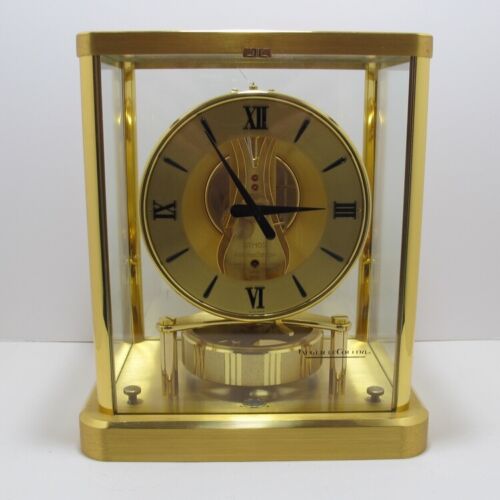
Otherwise known as shelf clocks, Mantel is another style of clock that was widely common in the 18th century with origination from France. As opposed to Grandfather’s clocks, Mantel clocks are relatively small houses meant to be placed on a mantel or shelf. They are beautifully designed and serve as an ornament to every home that has them. They are made from either wood or porcelain.
The French empire-style timepieces are a typical example of Mantle clocks. Mantel clocks were produced in different variants. Among them are the Ansonia, Bracket, steeple, skeleton, Tambour, and Art Décor are common Mantel that is still largely available in Antique Market.
3. Cuckoo clocks Sold $724.00
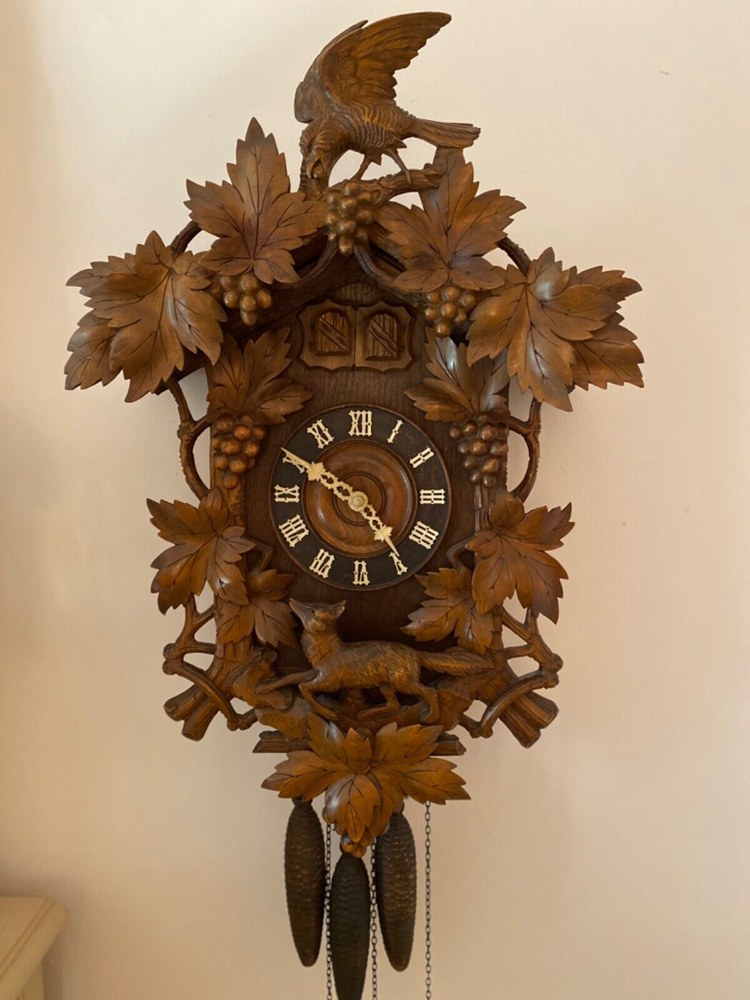
Cuckoo clocks are typically pendulum clock that alerts every hour in a cuckoo bird sound style. These are unique interactive clocks equipped with moveable figurines that sound like a cuckoo.
The clock existed in the middle of the 16th century and has maintained its sound mechanism since then. The origination of the clock is in doubt, but its evolution is much traceable to the black forest area in southwestern Germany.
Cuckoo clocks remain cherished antiques because of their artistic carved designs. They are typically carved with hunting and forest-related scenes like deer, rabbits, pheasants, hounds, and many beautiful woodland creatures.
4. Taverns Clocks Price $18,000
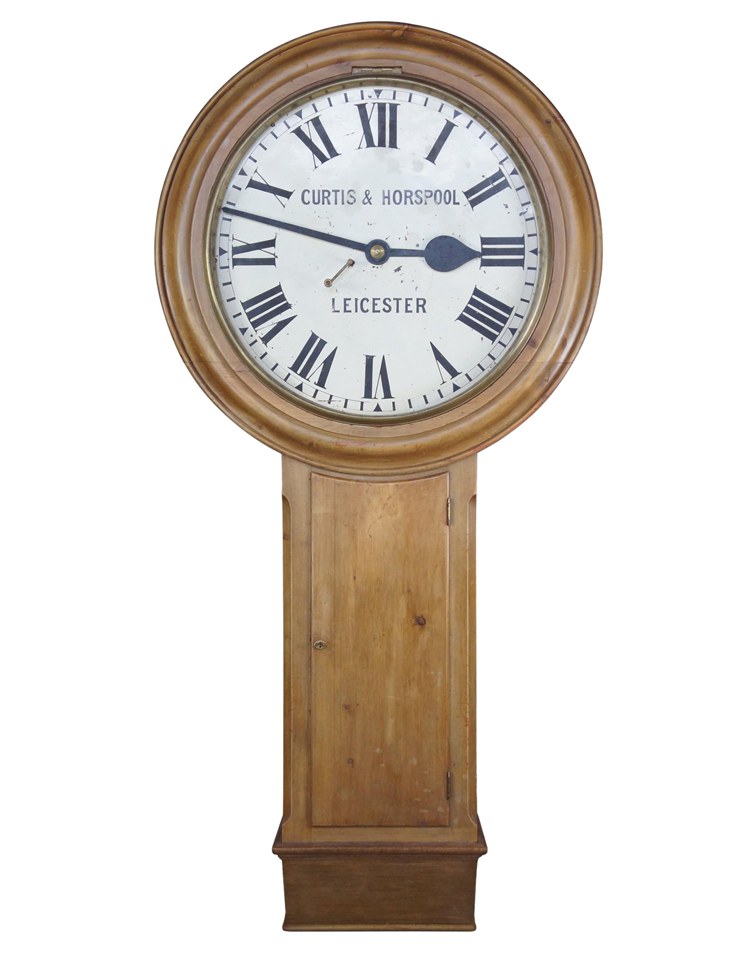
Otherwise known as the “Act of parliament clock’.
It is a wall clock common in the United Kingdom, and they were usually hung in inns and taverns. They are made in a plain design, and their diameter is generally 2-5 feet. The clock style emerged in the 1720s and was widespread throughout the 18th century.
The name tavern was given to the clock when parliamentary tax in the U.K. forced the clock owners to pay huge taxes so that the government could raise money for war efforts.
Many people discarded the clock to evade the tax. However, inns and taverns used this as a business strategy and equipped their building with a clock style to attract more customers.
5. Banjo Clocks Sold $1,247.22
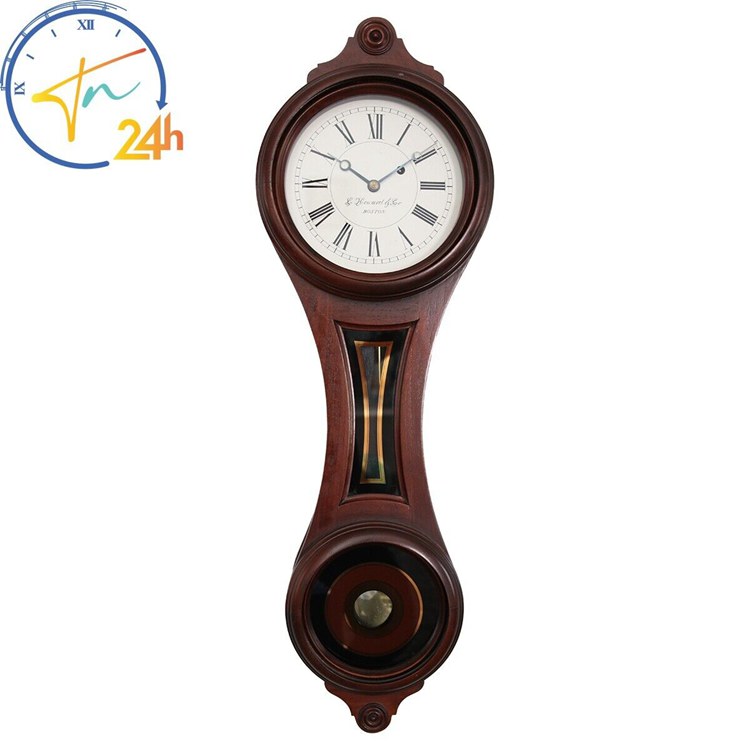
This clock style is an American timepiece that literarily resembles a Banjo-shaped case.
Simon Willard invented it in 1802. The clock has no striking mechanism and only indicates time by hand and dials.
This is why some instead called it a timepiece rather than an actual clock.
These clocks were decorated with beautiful carvings, brass figurines, and paintings.
6. Lantern Clocks Sold $935.00
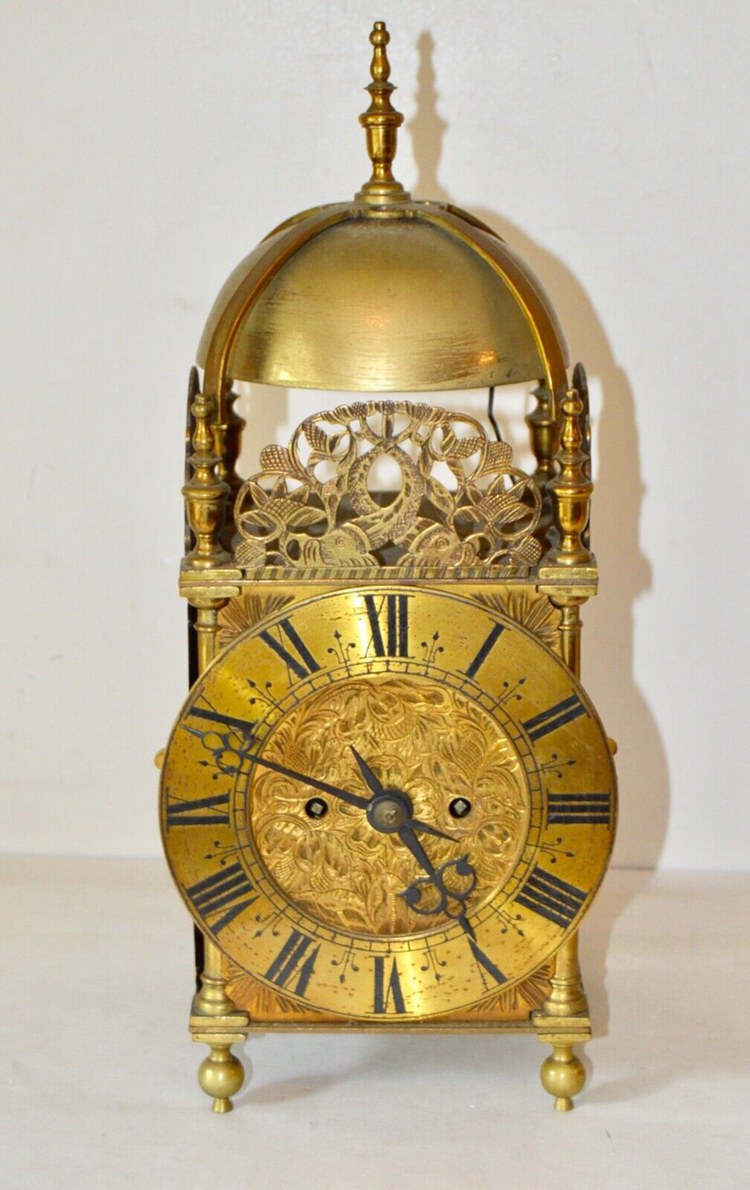
Some clocks shaped like lanterns were famous in the 17th century in Britain. Lantern clocks were adapted to use either anchor escapements or verge escapements.
Verge Escapements were first in use as they have short bob pendulums. Anchor Escapement came thereafter with the “seconds pendulum,” which gives a more accurate timepiece.
Unfortunately, they became obsolete in the 19th century as people moved to another clock style.
7. English Fusee Dial Clock
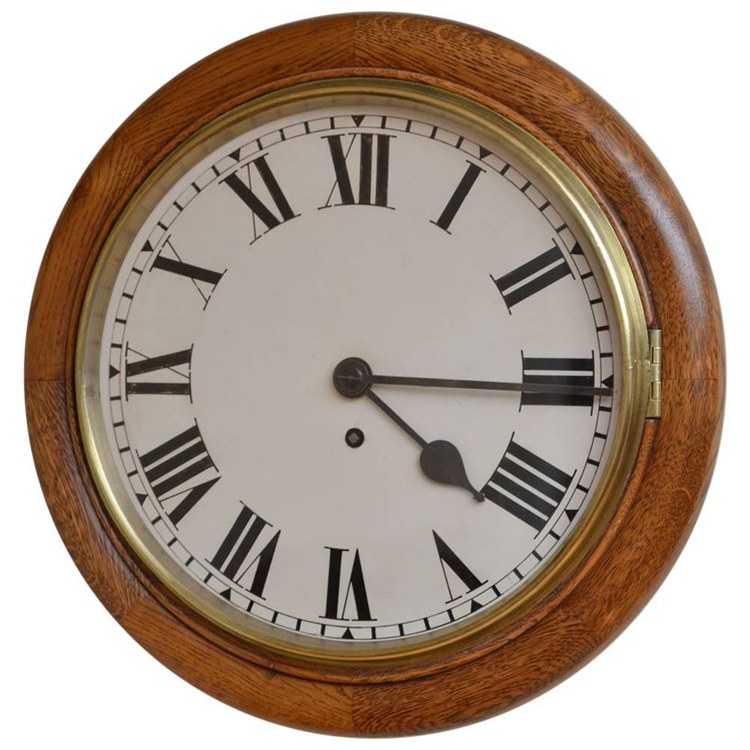
The Fusee is another ornate and colorful timepiece you can collect as antiques.
The clock emerged in the 17th century and was widely used in commercial venues like schools, pubs, banks, etc. The clock is made with a mahogany structure with bright colors and bold patterns. Fusee dial is typically painted with three colors- gold, blue, and red. It also features a pendulum that can be easily seen through glass panels. Its face is Magnolia shape and numbered in Roman numerals, and it is 24 inches in diameter.
8. Girandole Wall Timepiece
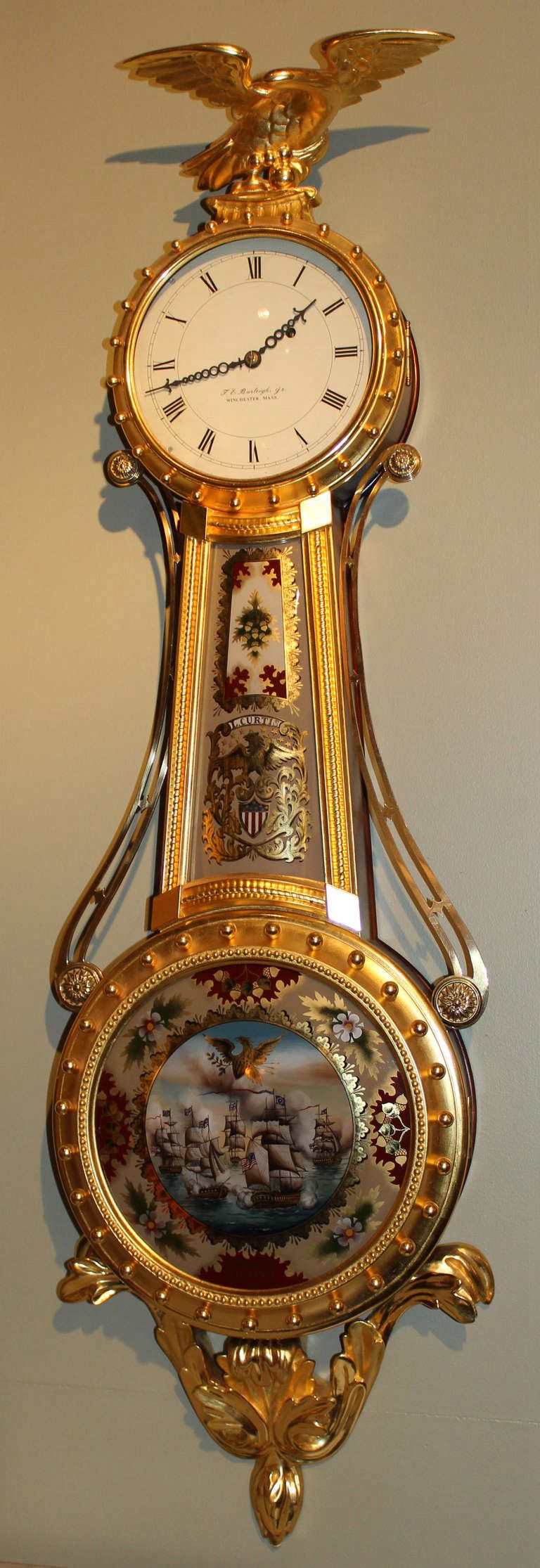
The Girandole wall is beyond an antique timepiece. It is a work of art that catch the attention of anyone that understands and values artistic work.
Lemuel Curtis makes the clock in Massachusetts in the early 19th century. It features sophisticated carvings and moldings, and the dial is metal painted. What makes it most appealing is the gold eagle perched design at the top of the clock. Its metal throat is painted with a delicate pattern, and the lower frame features an Aurora pulling a chariot. Beyond the physical look, the clock can run a week on one wind as it is not spring-powered. It is weight powered.
9. Japanese Single Foliot Kak Dokei
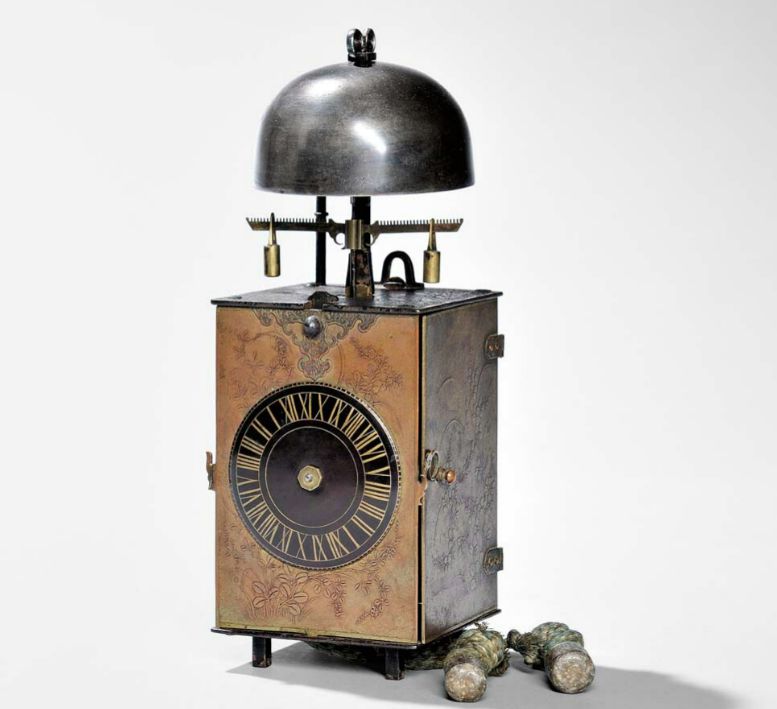
Clueing from the name, the clock originates from Japan, one of the most pricey clock antiques on the list due to its rarity.
The Japanese single is a 19th-century clock with a floral design. The design is a variant of a lantern clock. It features a 24-hrs system and strikes on weight-driven movement. Its hourly chime is under a bell supported on an iron stand with iron pillars and brass siding supporting the bell. It is 10 inches tall and can sit on a table or floor effortlessly. It is a verge escapement clock with iron wheels.
10. Cartel clock
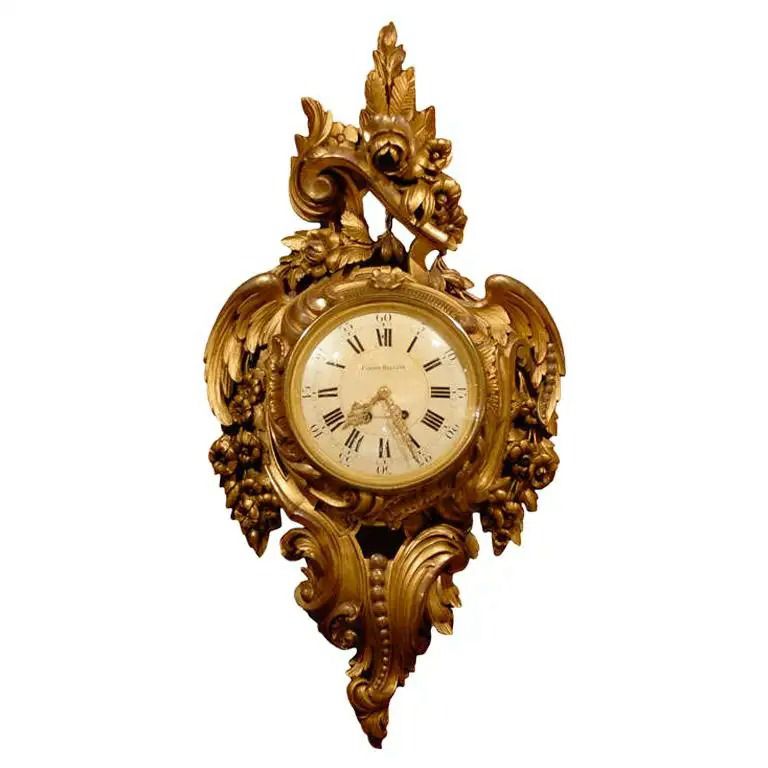
The cartel clock is another variant of wall lock desired by many antique collectors. It is designed in cartouche style and commonly made with gilt bronze. It has highly ornate and asymmetrical designs. The clock originated in Paris in the middle of the 18th century.
11. Torsion Pendulum Antique Anniversary Clocks
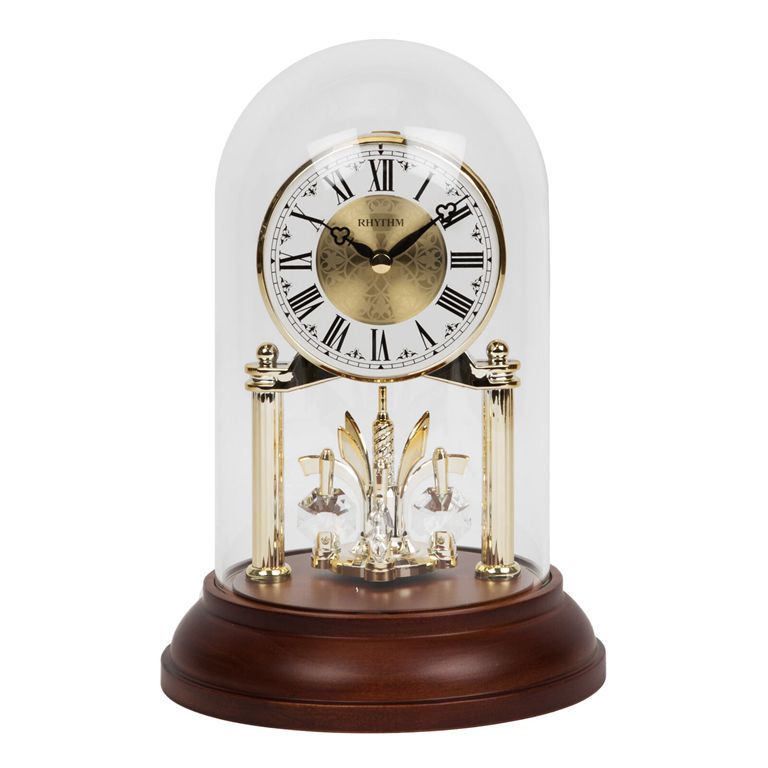
The Torsion Pendulum is called an anniversary clock because, on a single winding, it can run for a whole year. This is a mechanical clock that keeps time through the torsion pendulum. The clock is embedded inside a transparent glass case with a dial in the background and has a decorative wheel with either three or four chrome balls on ornate spokes. Robert Leslie invented it in the late 18th century. It is a highly beautiful clock and is only appreciated by those who understand antiques’ artistic value.
12. Carriage Clocks
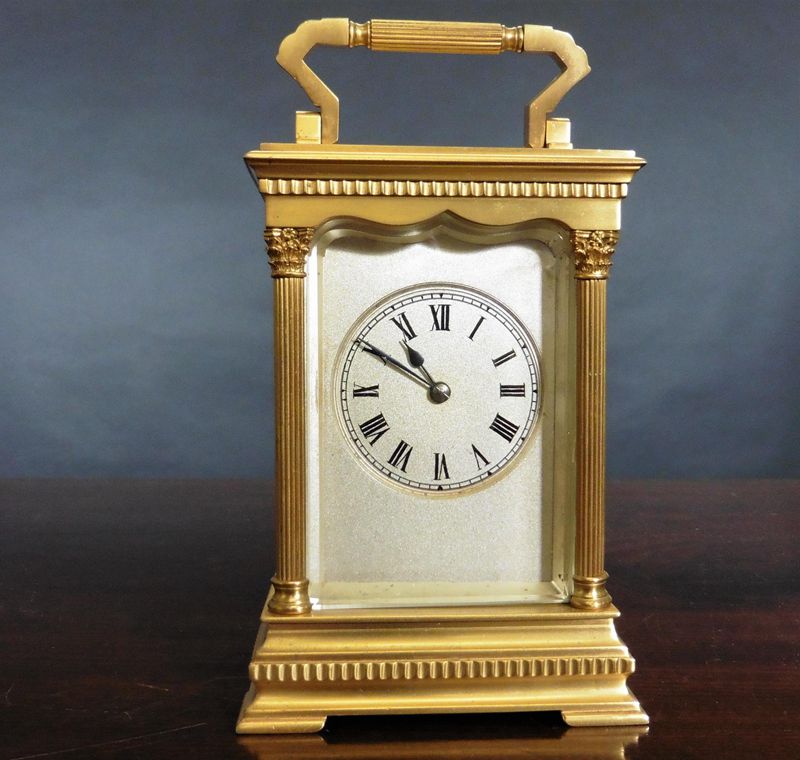
These are often small, and spring-driven clocks explicitly made for travelers. It was invented in France by Abraham-Louis in the early 19th century. It is usually in rectangular plain or gilt-brass case. It has a carrying handle for easy mobility. It uses a balance spring for timekeeping as against the popular pendulum bracket clock then. In recent times, it has served Antiquity and ornamental purpose. It is still a worthy clock you can get to beautify your room.
13. Porcelain Antique Shelf Clock
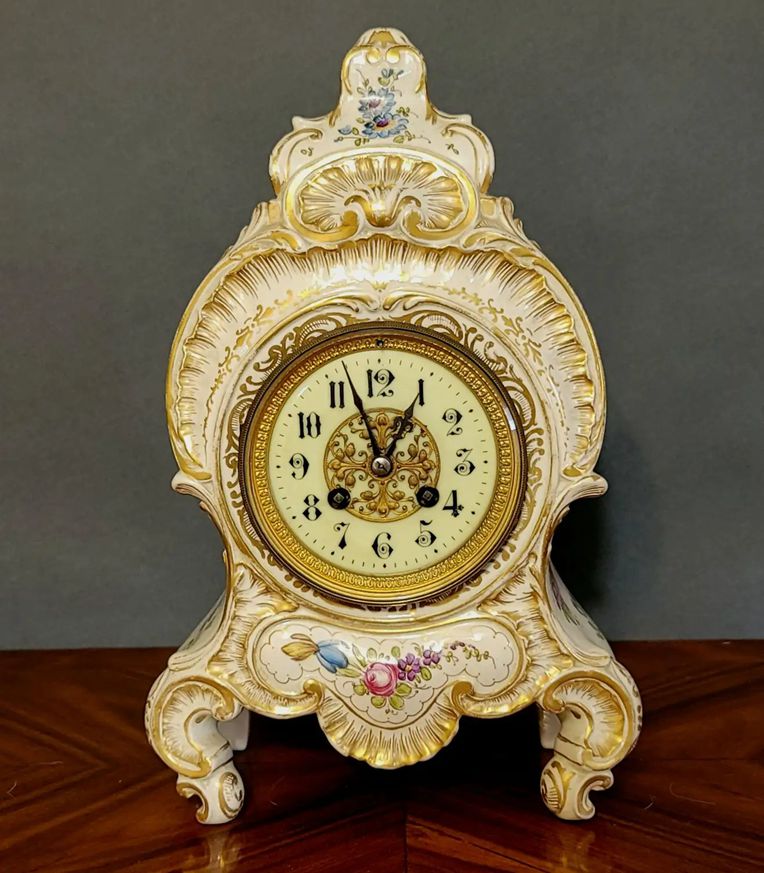
The beautiful mantel clock is made with porcelain material worth our mention. It is a beautifully crafted work that can be a good ornament on your room or office shelf. It is designed with Pista green and white colors. The clock has a rounded-shape dial with white background. The dial is encircled with brass both inside and outer of it.
14. Tripod Standing Clock
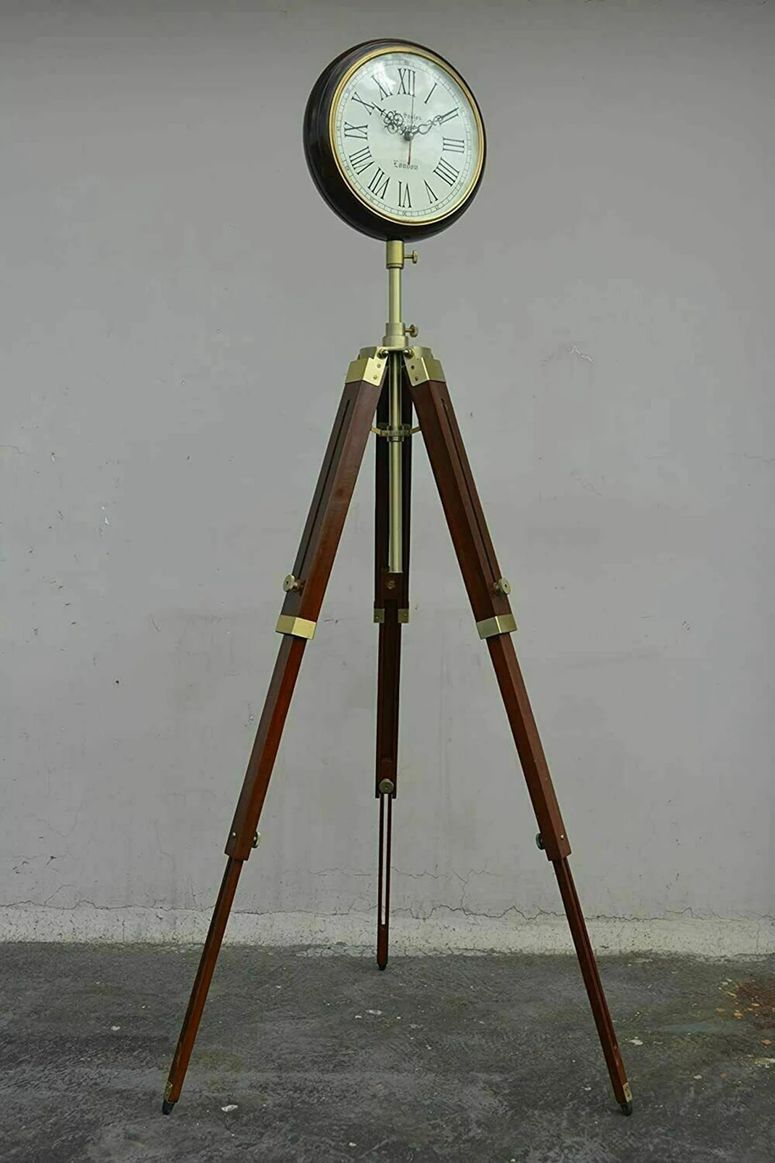
Tripod is an ancient dial clock that features Roman Numerals. It is a vintage-style clock made with wood, aluminum, and glass materials. The stand is made of wood, the clock face is covered with glass, and the rest part of the clock is aluminum. The Tripod stand is foldable, making it portable enough to move around. Its height is approximately 64 inches, and the clock is 11 inches. It is a great ornamental option for your
15. Double-Sided Station Clock
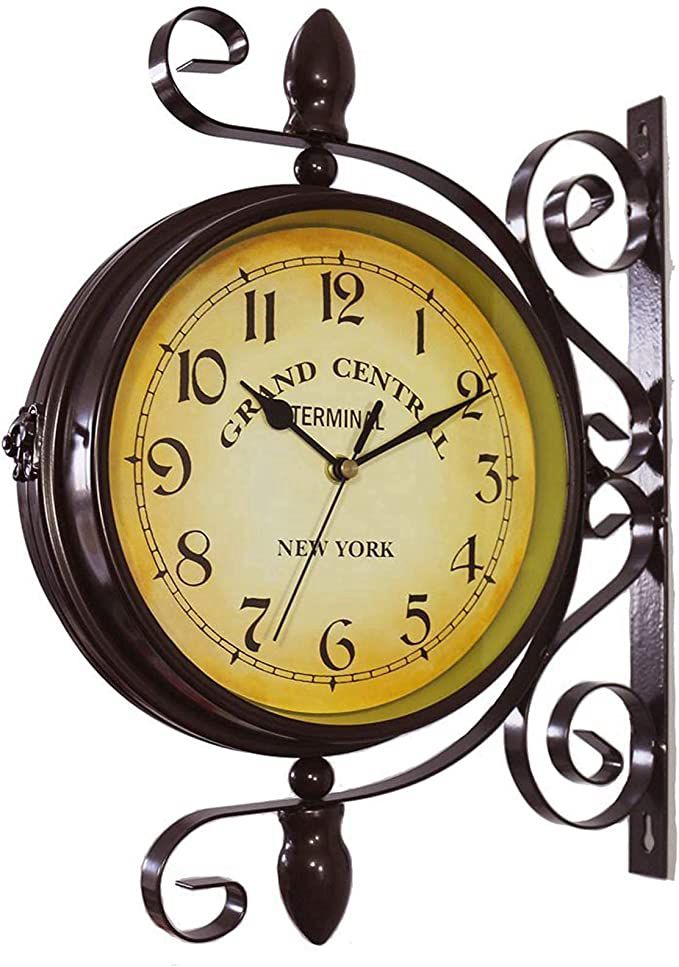
If you have ever been to a railway station, you must have seen a double-sided (clock with both sides’ faces) before. They can also serve as a decorative element to your living space or study area. And can even be a good gift idea for your loved one. It is a clock that has been in use since the 19th century and is still much desired in this modern time.
Identifying Antique Clocks patterns and Popular Design
Antique clock identification remains an issue for new antique collectors. With the emergence of new and more modern clock manufacturers, it can be quite puzzling to determine Antiquity or otherwise of some clocks, especially some brands that are uncommon in the antique market. Remember, the aim isn’t to buy a refurbished, repainted, or any form of remodeling clock. It is immensely rewarding and mind-fulfilling to recognize a clock is one of those being used in the past, and even know a little story about them, possibly.
Besides, antique clocks come in different sizes, designs, styles, materials, and working mechanisms. The clock has been in production for centuries, and they were made almost globally, too diverse. This is why identification is trickier. Here are simple guides to easily identify the Antiquity of your clock.
Maker’s name on antique clocks
Throughout the clock’s history, there were reputable manufacturers of what is now known as old clocks. Many clock manufacturing companies have emerged in America, Asia, South America, and Europe, and each company has its unique style of clock design.
Carefully search through the supposed antique clock’s body to find the maker’s name, and research online about the maker or pick up any reputable Antique clock books that write about the manufacturer’s company.
Many American clocks of the 19th century usually had their name inscribed on the timepiece or on the backplate of a clock movement. Some manufacturers engraved or printed their name on the center face of the clock’s dial. The name can also be printed on a label and pasted at the back of the clock or pasted inside the clock case.
However, paper pasted to the back or inside of a clock case may not survive, or on some occasions, the name that appears on the dial may not be the manufacturer’s name but the retailer that sold the clock. The reasons why other means of identification must be pursued.
Using Mark to identify the antique name
If a company name isn’t engraved, the company mark is another best alternative to identify the Antiquity of a clock. Though additional research may be conducted to understand the mark found in any antique clock.
The mark number can either be a serial number, trademark, or patent number, and they all serve as major clues for the identification process. Note that the location of these marks varies on every clock. Ensure you thoroughly search through every part of a clock you want to ascertain. However, not all clocks have a serial number, even though a serial number is a great lead to identifying a clock. Patent marks are another means of identification, but most antique manufacturers source their mechanisms from different places. They assembled many imported parts for a clock. A patent mark available on the clock may be a mechanism rather than the source of getting the complete manufacturer’s name.
Checking a mark’s name isn’t that complicated. There are many guidebooks that can reveal the best way to identify the manufacturer’s mark.
Clues to quick identification
Generally, there are indirect clues that can make you identify clock antiquity. Consider below clues
- Suppose you are able to find information about a similar clock. It may be useful for your research. But ensure the clock you are using is of the same style and type. They are likely to be of the same generation or even manufacturers. For instance, there are many mantel clocks on the market. Information about a mantel’s style of a clock may be assumed for another.
- The clock of the same glass, hand, or fasteners may be of the same generation. You can assume the information of one known as for the one unknown.
- Clock with the same strike movement, such as chime rod, gong, or bell, may have the same production era. There was a time each movement was popular. If you are able to identify a clock with a chime rod, such information may be sufficient for another chime rod clock you want to buy.
- The material used in making the dial is an interesting clue for identifying the Antiquity of a clock. Antique clock dials were made with ceramic, wood, tin, or even paper.
- Most manufacturers engraved dates on their clocks. Most time, the dating isn’t the clock manufacturing year but the date the company obtains a patent for the clock. However, it still serves as a reliable means of identification.
How to Determine Antique Clocks Values
Many old clock owners are usually in confusion about whether their old and long deserted clock is worth any value. If you are certain your clock is what can be categorized as antique and it is in good condition. Then it is worth a value. But how much exactly can it be worth? There is no precise answer to this. There are many factors affecting the value of any antique clock.
Factors Affecting Antique Clock Value
Originality
Original clocks are most appealing and valuable to collectors and buyers rather than the ones that have had many parts removed. Though determining the originality of a clock can be difficult to devise unless examined by an expert. A clock that has had parts like movements, dials, or hands replaced will sell less.
While it is necessary to restore some clocks so their glory can be maintained, it is necessary to mention that clocks with original features tend to sell higher.
Condition
Your clock may sell less than a similar clock even if they both maintain the same originality. If your clock condition isn’t in good shape, the price would be lessened. Clocks in good condition tend to garner a higher price than those with scratches, chips, or missing elements.
Rarity
As with every other Antique, rarity plays an important factor in the clock antique’s clock value. They are rare because they are out of production, and only a few are ready to sell them. And, the aged they become, the more they become scarce. A clock of over 300 years of age will be rarer than a barely a century-old clock. Generally, clocks that are rare to find but maintain buyer’s preference tend to sell higher than those that are still common.
Also, Clocks that are highly collectible due to their unique design, exceptional quality, or beauty tend to be in high demand and will naturally lead to scarcity. They will sell higher than a clock that is less in demand.
Clockmaker Marks
Clock with no attribution to any maker will sell less. Clocks are usually identified by their either trademark or name that can be found in some part of the clock. An antique clock that misses any of these inscribed in them may not be trusted and may experience low patronage.
Mechanism Type
Lastly, the three train clocks (chime, strike, and time) are preferred to clocks with only time and strike because they are regarded as being more complex. For instance, a three-weight Vienna Grande clock is priced higher than a single or two-weight variant of the same clock type.
Where to buy an Antique Clock
Buying an antique clock can be a bit different from buying a new clock from a store. Buying an antique clock is generally expensive as they serve more of an ornamental purpose than timekeeping. You can either buy an Antique clock online or offline.
Search through Auction houses or garage sales near you. You can also get it from reputable antique dealers or flea markets. If you are buying from a yet-to-be-trusted seller or from a private seller, we advise you to take an expert along for a proper inspection before buying.
You can also buy online, but ensure you are buying from an online platform that protects the buyer’s interest. Examples of reputable Antique platforms are eBay, Etsy, Loveantiqies, and Amazon.
F.A.Q.
What do I do if my antique clock stop working?
Seek professional repair rather than trying to fix it yourself. Old clock materials are generally fragile, and their parts can be weak. Don’t mess with the internal part or use oil to clean it. They may bring short time solutions, but they will eventually cause a further problem or even completely damage the clock. The problem with your antique clock could be something simple, don’t aggravate it.
How Can I Tell if an Antique Clock Is Fake?
There are more fake antiques than the genuine old clock. This is one of the big challenges the market is facing. Many people have reported scams and wasteful spending on what does not worth it. The most viable option to play safe is to look beyond the attractive look. Do thorough research about the clock and, most importantly, buy from reputable sources. Get a recommendation or honest, positive reviews.
Is there a difference between a grandfather and a grandmother clock?
They are both long case pendulum clocks, but grandmother clocks are not as tall as a grandfather clocks. Grandfather clocks generally measure between 6 to 7 feet, while grandmother clocks usually measure the height of 5 to 6 feet.
How often should an Antique clock be serviced?
A well-lubricated antique clock may not need any special servicing for a long time. Mechanical clocks are like cars, they need regular maintenance, and oiling is the best you can give them.
CONCLUSION
An antique clock can make the perfect beautification of any home. You are not wasting money buying one in your living room. But beyond their physical beauty, one needs to be extra careful before choosing the best. Understand the antecedent of any antique you are willing to buy, and make sure it is from a reputable manufacturer. Ensure it is in good working condition before buying.
Finally, learn the basics about the clock you want to buy. There are many authoritative book guides to read or, rather, an expert so you won’t buy a fake antique clock.






![Vintage Schwinn Bikes: [Types, Identification, and Values]](https://www.txantiquemall.com/wp-content/uploads/2022/05/5.-Schwinn-1967-Ramshorn-Fastback-Stingray-Sky-Blue-vtg-600x450.jpg)
